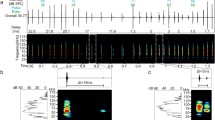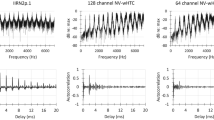Summary
For echolocation,Rhinolophus ferrumequinum emits orientation sounds, each of which consists of a long constant-frequency (CF) component and short frequency-modulated (FM) components. The CF component is about 83 kHz and is used for Doppler-shift compensation. In this bat, single auditory nerve fibers and cochlear nuclear neurons tuned at about 83 kHz show low threshold and very sharp filter characteristics. The slopes of their tuning curves ranged between 1,000 and 3,500 dB/octave and their Q-10 dB values were between 20 and 400, 140 on the average (Figs. 3–5). The peripheral auditory system is apparently specialized for the reception and fine frequency analysis of the CF component in orientation sounds and Doppler-shift compensated echoes. This specialization is not due to suppression or inhibition comparable to lateral inhibition, but due to the mechanical specialization of the cochlea. Peripheral auditory neurons with the best frequency between 77 and 87 kHz showed not only on-responses, but also off-responses to tonal stimuli (Figs. 1, 2, and 6). The off-responses with a latency comparable to that of N1-off were not due to a rebound from either suppression or inhibition, but probably due to a mechanical transient occurring in the cochlea at the cessation of a tone burst.
Similar content being viewed by others
References
Bruns, V.: Peripheral auditory tuning for fine frequency analysis by the CF-FM bat,Rhinolophus ferrumequinum. I. Mechanical specializations of the cochlea. J. Comp. Physiol.106, 77–86 (1976)
Bruns, V.: Peripheral auditory tuning for fine frequency analysis by the CF-FM bat,Rhinolophus ferrumequinum. II. Frequency mapping in the cochlea. J. Comp. Physiol.106, 87–97 (1976)
Grinnell, A.D.: Comparative auditory neurophysiology of neotropical bats employing different echolocation signals. Z. vergl. Physiol.68, 117–153 (1970)
Grinnell, A.D.: Rebound excitation (off-responses) following non-neural suppression in the cochleas of echolocating bats. J. Comp. Physiol.82, 179–194 (1973)
Henson, O.W., Jr.: The activity and function of the middle ear muscles in echolocating bats. J. Physiol. (bond.)180, 871–887 (1965)
Henson, O.W., Jr.: The perception and analysis of biosonar signals by bats. In: Animal sonar systems (ed. Busnell, R.G.), p. 949–1003. Jouy-en-Josas, France: 1967
Johnson, R.A., Henson, O.W., Jr., Goldman, L.R.: Detection of insect wing beats by the bat,Pteronotus parnellii. J. acoust. Soc. Amer.55, 853 (1974)
Long, G.R., Schnitzler, H.-U.: Behavioral audiogram from the bat,Rhinolophus ferrumequinum. J. Comp. Physiol. (in press)
Neuweiler, G.: Neurophysiologische Untersuchungen zum Echoortungssystem der Grossen HufeisennaseRhinolophus ferrumequinum Schreber, 1774. Z. vergl. Physiol.67, 273–306 (1970)
Neuweiler, G., Schuller, G., Schnitzler, H.-U.: On- and off-responses in the inferior colliculus of the greater horseshoe bat to pure tones. Z. vergl. Physiol.74, 57–63 (1971)
Nomoto, M., Suga, N., Katsuki, Y.: Discharge pattern and inhibition of primary auditory nerve fibers in the monkey. J. Neurophysiol.27, 768–787 (1964)
Pfeiffer, R.R.: A model for two-tone inhibition of single cochlear nerve fibers. J. acoust. Soc. Amer.48, 1373–1378 (1970)
Pollak, G., Henson, O.W., Jr., Novick, A.: Cochlear microphonic audiograms in the “pure tone” batChilonycteris parnellii parnellii. Science176, 66–68 (1972)
Sachs, M.B., Kiang, N. Y.-S.: Two-tone inhibition in primary auditory nerve fibers. J. acoust. Soc. Amer.43, 1120–1128 (1968)
Schnitzler, H.-U.: Die Ultraschall-Ortungslaute der Hufeisen-Fledermäuse (Chiroptera-Rhinolophidae) in verschiedenen Orientierungssituationen. Z. vergl. Physiol.57, 376–408 (1968)
Schnitzler, H.-U.: Echoortung bei der FledermausChilonycteris rubiginosa. Z. vergl. Physiol.68, 25–38 (1970)
Schnitzler, H.-U., Suga, N., Simmons, J.A.: Peripheral auditory tuning for fine frequency analysis by the CF-FM bat,Rhinolophus ferrumequinum. III. Cochlear microphonics and auditory nerve responses. J. Comp. Physiol.106, 99–110 (1976)
Schuller, G.: Echoortung beiRhinolophus ferrumequinum mit frequenzmodulierten Lauten. Evoked potentials im Colliculus inferior. J. Comp. Physiol.77, 306–331 (1972)
Schuller, G., Beuter, K., Schnitzler, H.-U.: Response to frequency-shifted artificial echoes in the batRhinolophus ferrumequinum. J. Comp. Physiol.89, 275–286 (1974)
Simmons, J.A.: Response of the Doppler echolocation system in the batRhinolophus ferrumequinum. J. acoust. Soc. Amer.56, 672–682 (1974)
Suga, N.: Recovery cycles and responses to frequency modulated tone pulses in auditory neurones of echolocating bats. J. Physiol. (Lond.)175, 50–80 (1964)
Suga, N., Jen, P.H.-S.: Peripheral control of acoustic signals in the auditory system of echolocating bats. J. exp. Biol.62, 277–311 (1975)
Suga, N., Simmons, J.A., Jen, P.H.-S.: Peripheral specialization for fine analysis of Doppler-shifted echoes in “CF-FM” batPteronotus parnellii. J. exp. Biol.63, 161–192 (1975)
Suga, N., Simmons, J.A., Shimozawa, T.: Neurophysiological studies on echolocation system in awake bats producing CF-FM orientation sounds. J. exp. Biol.61, 379–399 (1974)
Author information
Authors and Affiliations
Additional information
We thank Alexander von Humboldt Stiftung, Deutsche Forschungsgemeinschaft (Grant No. Ne146/6-8), Stiftung Volkswagenwerk (Grant No. 111858), and American National Science Foundation (Grant No. 40018 and BMS 75-17077) for their support for our cooperative work.
Rights and permissions
About this article
Cite this article
Suga, N., Neuweiler, G. & Möller, J. Peripheral auditory tuning for fine frequency analysis by the CF-FM bat,Rhinolophus ferrumequinum . J. Comp. Physiol. 106, 111–125 (1976). https://doi.org/10.1007/BF00606576
Received:
Issue Date:
DOI: https://doi.org/10.1007/BF00606576




